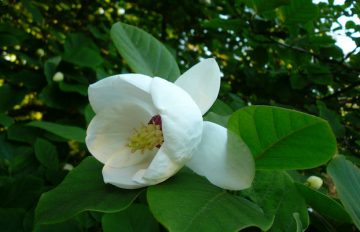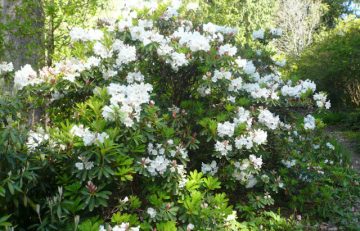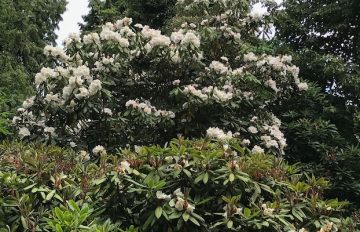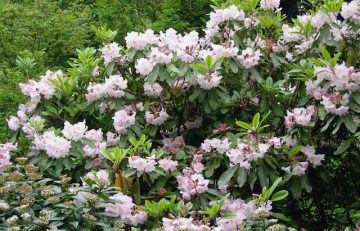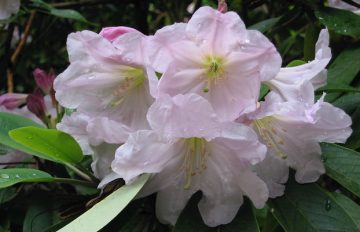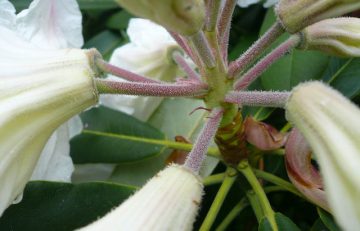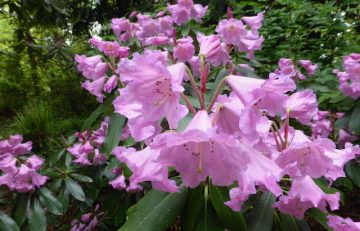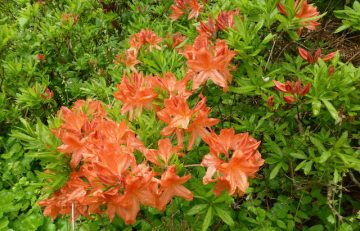
Rhododendron molle subsp japonicum
Although April is the peak of rhododendron bloom in the David C. Lam Asian Garden, there are plenty more to come in May. The Azalea Glade, which is reached off of Henry and Fortune Trails, east of Upper Asian Way, holds a few treasures in this regard. At least two forms of Rhododendron campylogynum should be flowering there in May: Rhododendron campylogynum Myrtilloides Group (very dwarf plants) and Rhododendron campylogynum Charopoeum Group (plants with larger flowers). The white-flowered Rhododendron ‘Leucanthum’ was once considered another variant of the species, but it has been deemed a hybrid. Rhododendron oreotrephes is the picture of elegant understatement with its aromatic, small bluish leaves and lavender-mauve flowers. This species is in the same group as the flashier and more familiar R. augustinii. Steps away, the full-bodied orange flowers of the deciduous azalea, Rhododendron molle subsp. japonicum, command attention (whether orange is your thing or not). Along Upper Asian Way look out for the richly purple-flowered Rhododendron trichanthum, which is one of the later-flowering species in the R. augustinii alliance (technically, section Rhododendron subsection Triflora, which also includes R. oreotrephes).
The white- to rosy-pink-flowered Rhododendron qiaojiaense (“cheow-jee-en-see”) was only named scientifically in 2016, though plant explorers have known it as early as the 1990s in the wild in Yunnan, China. The phenomenal bud-set this year will translate into an outstanding floral display in May. There is a pair of small plants on Delavay Trail, west of Kingdon Ward Way and several larger ones along Hu Trail east of Sargent Trail, though the latter are still labeled as R. decorum subsp. cordatum (an early, provisional name). Described scientifically in 2008, Rhododendron qiaojiaense is a close relative of the larger-growing, Rhododendron decorum subsp. decorum. The finest of our “decorums” is located on Ludlow Trail, just above Lower Asian Way. The subspecies diaprepes is more tree like, and usually later to bloom, but ours, Rhododendron decorum subsp. diaprepes ‘Gargantua’ (a particularly arborescent, large-flowered selection), started flowering in mid-April. There are two plants, one north of Siebold Trail between Rock and Decaisne Trails, and an even taller one where Handel-Mazzetti Trail crosses Tschonoski Trail.
Several more in this stalwart group (subsection Fortunea) flower in May, with a few species normally opening their blooms as late as June or July. Rhododendron fortunei subsp. discolor may still have a few left in early May, but Rhododendron fortunei subsp. fortunei flowers are often emerging a week or so later. One of the finest selections of this species ‘Sir Charles Butler’, with palest pink flowers, is on Siebold Trail at Stearn Trail. All bets are off regarding flowering times after the winter we just experienced, but we can be sure that at least some of our magnificent Rhododendron glanduliferum (normally June-flowering with large white to pale pink, wintergreen-scented blooms), will produce a few good trusses in May. Multiple specimens are located along Lower Asian Way below Wharton Glade as well as on the west side of the path closer to Kingdon Ward Way.
Further to the south and east is Rhododendron maoerense, another tough, tree-like rhododendron. As with R. glanduliferum, there are conspicuous glands on the flower stalks, but the stalks in R. maoerense are longer and the trusses more open and upright. The flowers are larger and a strong rosy pink. Look for this species on Lower Asian Way at the west end of Soulie Loop and where Handel-Mazzetti Trail meets Meyer Glade. While visiting this part of the Garden, note that there are two deciduous magnolias here that regularly bloom in May. Magnolia sieboldii has nodding, cup-shaped flowers, while the closely-related Magnolia wilsonii has larger, more pendant blooms. Both smell deliciously of lemon blossom. The two are located next to each other, below Lower Asian Way south of Little Tsangpo Creek. They have multi-stemmed spreading crowns and broad leaves that hint at their tolerance for shaded spaces.
- Magnolia sieboldii
- Rhododendron ‘Leucanthum’
- Rhododendron campylogynum Caropoeum Group
- Rhododendron campylogynum Myrtilloides Group
- Rhododendron decorum subsp decorum
- Rhododendron decorum subsp diaprepes ‘Gargantua’
- Rhododendron fortunei subsp fortunei ‘Sir Charles Butler’
- Rhododendron fortunei subsp fortunei ‘Sir Charles Butler’
- Rhododendron glanduliferum
- Rhododendron glanduliferum
- Rhododendron maoerense
- Rhododendron maoerense
- Rhododendron molle subsp japonicum
- Rhododendron oreothrephes
- Rhododendron trichanthum
Submitted by: Douglas Justice, Associate Director, Horticulture and Collections

